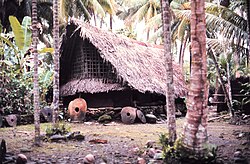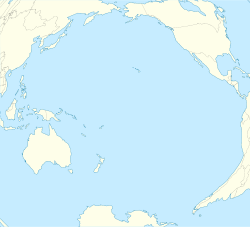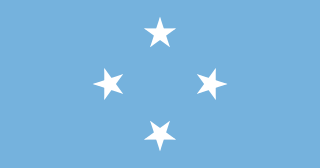
The Federated States of Micronesia, or simply Micronesia, is an island country in Micronesia, a subregion of Oceania. The federation consists of four states—from west to east, Yap, Chuuk, Pohnpei and Kosrae—that are spread across the western Pacific. Together, the states comprise around 607 islands that cover a longitudinal distance of almost 2,700 km (1,700 mi) just north of the equator. They lie northeast of Indonesia and Papua New Guinea, south of Guam and the Marianas, west of Nauru and the Marshall Islands, east of Palau and the Philippines, about 2,900 km (1,800 mi) north of eastern Australia, 3,400 km (2,100 mi) southeast of Japan, and some 4,000 km (2,485 mi) southwest of the main islands of the Hawaiian Islands.

The Federated States of Micronesia are located on the Caroline Islands in the western Pacific Ocean. The history of the modern Federated States of Micronesia is one of settlement by Micronesians; colonization by Spain, Germany, and Japan; United Nations trusteeship under United States-administered Trust Territory of the Pacific Islands; and gradual independence beginning with the ratification of a sovereign constitution in 1979.

Micronesia is a subregion of Oceania, consisting of about 2,000 small islands in the Northwestern Pacific Ocean. It has a close shared cultural history with three other island regions: Maritime Southeast Asia to the west, Polynesia to the east, and Melanesia to the south—as well as with the wider community of Austronesian peoples.
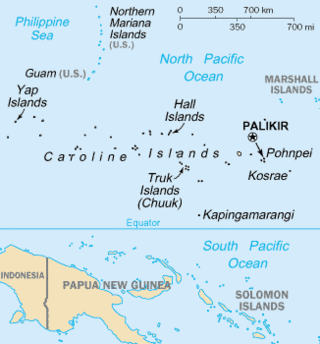
The Caroline Islands are a widely scattered archipelago of tiny islands in the western Pacific Ocean, to the north of New Guinea. Politically, they are divided between the Federated States of Micronesia (FSM) in the central and eastern parts of the group, and Palau at the extreme western end. Historically, this area was also called Nuevas Filipinas or New Philippines, because they were part of the Spanish East Indies and were governed from Manila in the Philippines.
The Micronesians or Micronesian peoples are various closely related ethnic groups native to Micronesia, a region of Oceania in the Pacific Ocean. They are a part of the Austronesian ethnolinguistic group, which has an Urheimat in Taiwan.

A rai stone, or fei stone, is one of many large artifacts that were manufactured and treasured by the native inhabitants of the Yap islands in Micronesia. They are also known as Yapese stone money or similar names.

The State of Yap is one of the four states of the Federated States of Micronesia, located in the westernmost portion of the country. The state borders Palau to the southwest, Guam to the north, and Chuuk State to the east. According to the state's population census carried out in 2020, the total population is 11,577 residing across a total area of 119.54 sq km, though a large majority of the area is water. The only town area in the state, Colonia, serves as the state capital.
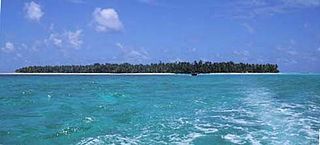
Satawal is a solitary coral atoll of one island with about 500 people on just over 1 km2 located in the Caroline Islands in the Pacific Ocean. It forms a legislative district in Yap State in the Federated States of Micronesia. Satawal is the easternmost island in the Yap island group and is located approximately 70 kilometers (43 mi) east of Lamotrek.
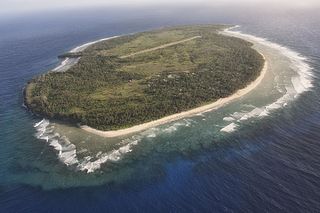
Fais Island is a raised coral island in the eastern Caroline Islands in the Pacific Ocean, and forms a legislative district in Yap State in the Federated States of Micronesia. Fais Island is located approximately 87 kilometres (54 mi) east of Ulithi and 251 kilometres (156 mi) northeast of Yap and is the closest land to Challenger Deep, about 180 miles away.
David Dean O'Keefe was an Irish-American ship captain who became a historical and political figure on the Western Pacific island of Yap.

Tomil or Tamil is a municipality on the island of Yap, in the Federated States of Micronesia. It consists of twelve distinctive villages: Meerur, Teb, Aff, Bugol, Doomchuy, Deechmur, Dilag, Maa', Thol, Madl'ay, Gargey, and Daaboch. Tomil occupies the southern portion of Gagil-Tamil Island, except for Gargey village, which is located on the main island of Yap.

Fanif is a municipality in the state of Yap, Federated States of Micronesia. Fanif encompasses the northwesternmost part of the main island and is the location of Yap proper's highest point, Mount Taabiywol, at 178 meters/584. Gilfith is the head village of Fanif. Fanif straddles the northern part of the main Island of Yap and includes the villages of Yyin, Quayrech, Ruunuw, Wuluuq, Malawaay, Rumuuq, Qatliw, and Raeng. It has two elementary schools, Fanif and North Fanif. A paved road runs through the villages along the northwest coast of Fanif into Weloy to the South and connecting into the Tomil - Colonia Road to the Northeast. The west coast is also accessible by boat from Colonia via the Tagireeng Canal.
T

Gagil is a municipality in the state of Yap. It forms part of Gagil-Tamil Island and covers the eastern side of the island. It has a population of roughly 400 people scattered in village groups. One of these villages includes the village of Gachpar which was once the capital of the historic Yap Islands Empire that lasted from about 10th to the 15th century AD and stretched as far as east as the west halls of Chuuk Lagoon, as far south as the northern atolls of Papua New Guinea, and as far west as the outer islands of Palau. The Yap Islands Empire centered in Gagil and it, and the Tui Tonga Empire of Tonga, are the only empires that existed in the ancient history of the Pacific Islands.

Wa are traditional sailing outrigger canoes of the Caroline Islands, Palau, and Yap. They have a single outrigger. They are similar to the sakman of the Northern Marianas.
Tarang, also known as O'Keefe's Island is a small island in the main harbor of Yap Island in the Federated States of Micronesia. It is located roughly in the center of the harbor east of Colonia, the Yapese capital, between Pekel and Bi Islands. It is a low island with a maximum height of about 22 feet (6.7 m), and is overgrown with tropical vegetation. The island has local historical importance as the home of Captain David O'Keefe, an enterprising American who arrived on Yap in the 1870s, and was responsible for not only significant economic growth, but also for the depreciation of the distinctive Yapese currency, the large rai stones which became devalued after O'Keefe introduced iron tools that made manufacture of the stones easier. O'Keefe settled on Tarang, where he had a boat landing, coal warehouse, and house. Of these structures, only the boat landing has survived; only foundations survive of the others.

The Yapese people are a Micronesian ethnic group native to the main island of Yap. Yapese culture is built on the maxim: Respect and Responsibility. Aspects of traditional Yapese culture are still important in modern Yapese culture.

Yap Day is a legal holiday in Yap State, one of the four states of the Federated States of Micronesia (FSM), held annually on March 1. It is a celebration of traditional Yapese culture. Common activities held during this time include competitions and traditional dances.
Religion in Yap is predominantly Roman Catholic, which first arrived in Yap in the late 1880s. Before that, the Yapese people practiced traditional rituals and practices and held beliefs about the gods, the spirits, taboos, and death. Through the efforts of Capuchin and Jesuit missionaries, the Catholic Church eventually became the dominant church on Yap. Other religions on Yap include Protestantism and other Christian sects.

The Yapese Empire was an ancient maritime empire located in the western Caroline Islands in the north Pacific region of Micronesia. In circa 950 AD, Yap became the seat of the Empire when the Gatcheper Village in the chiefdom of Gagil established an expansive maritime trade network and exerted socio-economic and political influence to its neighbouring islands to the east. Although small and informal compared to other marine empires, the Empire at its peak covered over 1,300 kilometres, stretching from the Yap main islands to parts of modern-day Chuuk State. The Empire coexisted with the Tongan Empire located in the southern Pacific.
The traditional councils of the Yap State are two assemblies of traditional leaders: the Pilung Council for the chiefs of the Yap Islands and the Tamol Council for the chiefs of the Outer Yap Islands. They have been established in 1992 by the Constitution of the Yap State, within the Federated States of Micronesia. The executive, the legislative, the judiciary and the traditional councils are the four institutional branches of government in the Yap State, but the councils, unlike the others, transcend the concept of the separation of powers. The councils are responsible for exercising the functions that relate to tradition and custom, which are not required to be recorded in the written law. In the Yap State, custom and tradition prevail over any interpretation of the constitution and even over any judicial decision. The councils have the right to veto legislation that they consider to be contrary to traditional practices. The constitutionality of these councils and their veto power could be challenged under the Micronesian Federal Constitutional Law, but to this date no one has done it.





![A large (approximately 2.4 m [7.9 ft] in height) example of Yapese stone money (Rai) in the village of Gachpar Yap Stone Money.jpg](http://upload.wikimedia.org/wikipedia/commons/thumb/5/54/Yap_Stone_Money.jpg/220px-Yap_Stone_Money.jpg)
